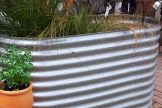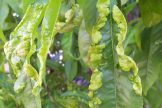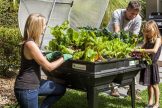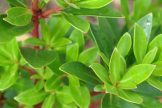
August is the season for change. In Aboriginal seasons, this is Guling – when orchids start to bloom. The days are lengthening and the plants are responding. This season of change brings out the drama queens in the garden. There is the purple and gold of the Hardenbergia and Acacia, reds and yellows of the Leucadendron and Magnolia cups are opening on bare branches. The Camellia japonicas are having their colourful moment and the Daphne, Osmanthus and Boronias are at their fragrant best.
We have already had our fair share of frosty mornings and more are likely, so continue on with those frost damage prevention measures for a few more weeks yet. Most important of all, look out for bud swell on your stone fruit. Now is the time to spray copper onto the buds to prevent leaf curl. August is also the time to remove all the galls on your citrus.
It is still an excellent time to plant bare root deciduous trees. We have specimen trees like Japanese maples, Gingko, smoke bush and weeping cherries, as well as fruit trees, berries, grapes and vines. Bare root roses are also in stock.

Edible Gardening in August
Hard to get and expensive fresh vegies has encouraged people to try their hand at growing winter veg this year. If you are nervous about this our staff are always happy to give advice. In addition we have many many fact sheets on our website – use the search function – it is very helpful. August is an excellent month to plant your seed potatoes, asparagus, strawberries and rhubarb. Use only seed potatoes to avoid introducing diseases into the soil. Asparagus will last for many years so choose an area where it won’t need to be disturbed. Rhubarb is another perennial which will do well left undisturbed so prepare the soil well before planting with loads of manure and compost.
In the vegetable garden it’s time to plant seed or seedlings of asian greens, beetroot, broccoli, cabbage, carrots, cauliflower, celery, kale, leek, lettuce, onions, parsley, parsnip, peas, radish, rocket, silverbeet and spinach. Peas eaten fresh from the pod are delicious and children love them. It’s the start of the season to plant globe artichokes, strawberries, turnips, chicory, sunflowers and your last chance to plant jerusalem artichokes and spinach by seed.
Edibles to plant in Melbourne in August.
Below is a list of edible gardening seeds and seedlings that can be planted in August. Please keep in mind that this list has been developed for Melbourne’s climate. Some of the plants indicated will be either right at the start or the end of their ideal planting season, click the links to the factsheets for more detailed planting information.
 – Seeds – Seeds – Seedlings – Seedlings
|
 – Tubers / Crowns – Tubers / Crowns – Companion Plants – Companion Plants
|
 – Protect from frost – Protect from frost – Prone to Cabbage Butterfly – Prone to Cabbage Butterfly
|
Angelica Arrowroot  Artichokes (Jerusalem)  Asparagus  Bok Choy  Beetroot   Broccoli   Broccoletti   Broccolini   Cabbage    Carrot  Cauliflower  Chamomile   Chervil  Chicory  Chives  Coriander  Cress  Curry Plant  Endive  Feverfew  
|
Garlic Giant Red Mustard  Good Bug Mix   Kale   Kohlrabi  Lemon Balm  Lettuce   Lovage  Marjoram  Mint  Mitsuba  Mizuna  Mustard Greens   Mustard Mizuna  Onion  Oregano  Pak Choy / Bok Choy  Parsley  Peas  Radicchio   Radish  
|
Rhubarb Rocket / Arugula  Rosemary  Saffron Crocus  Sage   Salad Burnett  Savory   Shallots  Silverbeet  Sorrel  Spring Onion   Strawberries  Tarragon   Tatsoi   Thyme  Warrigal Greens   Wasabi  Watercress  Witloof  
|
Companion Planting
Let nature control pest out breaks in your kitchen garden by planting some beneficial insect attracting flowers in the garden. Go for mixes of alyssum, foxglove, echinacea, bergamont, poppies and calendula. Also, plant some coriander and dill to allow to go to seed. Companion plants camouflage your edible plants from insects, enhance growth in some cases, and as a bonus some are edible, such as borage, pansies, viola, calendula and nasturtium. Click here for our companion planting factsheet.
Put down some rich compost or well aged manure around the drip lines of your fruit trees.
Prepare other beds for your summer vegetables by incorporating organic matter such as well-rotted compost , blood and bone and animal manures. Green manure crops should be dug in now before their stems become too woody.
For those of you with glasshouses / hothouses or similar you can try your luck at getting an early start with sowing seeds of tomatoes, chillies and eggplants. The seeds can also be germinated on a sunny windowsill indoors. You can also plant seedlings of basil and early, more cold tolerant tomatoes in your greenhouse. Early tomato seedling varieties include Apollo, Rouge de Marmande, KY1 and Roma.
Spring Into Seeds, Bulbs & Seedlings
We now have our spring-summer seed range in stock, with tomatoes, cucumbers, zucchinis and lots of other delectable summer delicacies! We also now stock a large range of organic, non-hybridised herb and vegetable seeds. The seed of these can be collected to produce another generation of true-to-type produce. In the shop also we now have summer flowering bulbs, such as Oriental Lilies and Peony Roses. Ideally try to get these in by the end of August for a good summer display.
Now is the time to plant both summer and autumn flowering bulbs and tubers, such as Cannas, Dahlias, Liliums, Lily of the Valley, Hippeastrum, Tuberose, Nerines, Gladioli and Alstromeria. Prepare the soil by mixing in plenty of manure and don’t forget to put the stakes in now for the tall Dahlias and other tall flowering plants.
It’s also time to plant summer flowering seedlings such as Snapdragons, Hollyhocks, Verbena and Lupins. Marigolds and Petunias can be planted now, but you will need to provide protection from late season frosts.
Pruning & Re-potting
If you didn’t prune your Apricots in autumn (preferred time of year) you can prune them once they start flowering, which normally occurs towards the end of August (pruning in winter allows entry of bacterial gumosis).
Winter flowering native shrubs that have finished flowering should be tip pruned to keep them compact and to encourage bushy growth. Native shrubs may be fertilised with blood and bone at half the recommended rate, or use a native fertiliser mix.
Many jonquils and daffodils will have finished their flowering. Cut off the spent flower heads but leave the foliage to die back naturally. They need to do this in order to store nutrients in the bulb.
Continue to liquid feed winter / spring flowering annuals every two weeks with a complete liquid fertiliser. Late this month is the time to prune Hibiscus and Gardenias and then fertilise them and other flowering evergreen shrubs with an all purpose organic fertiliser and mulch well.

Repot overcrowded cacti and succulents. Use a cacti and succulent mix and pot them up into a larger pot. Any broken bits can be planted up and you may even get new plants out of them.
Repot your ferns and other indoor plants and remove any dead or damaged growth.
Remove spent blooms on your Azaleas and Camellias. New growth buds occur at the back of each flower. When they have completely finished flowering give them a dose of Azalea and Camellia fertiliser.
If you have not already pruned your roses, now is the time to do so. Remember to clean and sharpen secateurs and prune with the aims of cutting out dead wood, improving air circulation, creating strong structure, and especially promoting flowering. Fertilise with an organic Rose Food later this month to promote new spring growth. Spraying Lime Sulphur or Copper Sulphate on the bare stems at this time can help prevent fungal disease. Also remember to spray Peaches and Nectarines for Leaf Curl disease (more info below) just as the buds begin to swell.
Pests, Diseases & other annoyances
Fruit Tree Issues
To help control overwintering pests and diseases, it’s your last chance to clear up any fallen debris from underneath the trees and in the branch junctions of the trees. Make sure any healthy prunings go to the green waste recycling or are chopped up in a hot compost. Also scout for and remove any overwintering pests at the base of trees, in the cracks of bark, in rough bark and within the branch junctions.
Grapes can be sprayed with lime sulphur just before bud burst to help control fungal problems and the ‘Grape Blister Mite’
For your deciduous trees, if you’ve had problems occurring, like scale, bacterial and fungal diseases, you may want to do a winter spray with Bordeaux, copper or lime sulphur.
Growers of fruit trees, such as peaches, nectarines, almonds and occasionally apricots, have all been confronted at one time or another with the new leaves on their trees becoming thickened with blisters and curling up. The blisters start off red in colour, then turn white with a bloom of fungal spores.
Peach Leaf Curl is a fungal disease that infects Peaches, Nectarines, Almonds and other Prunus species. The symptoms are noticed in spring and summer, when the leaves appear with raised lumpy light green and red patches and are curled up. This problem weakens the tree if it occurs year after year, and will result in a reduced fruit yield. Once you see the symptoms, it is too late to spray. The trees should be sprayed from mid-to-late winter from bud swell until the leaves emerge. Spray with Copper oxychloride during this period, and again after rain, as the rain will wash off the spray. This is a preventative spray, so the swelling buds need to be covered with the copper spray. The nursery puts up signs when we spray our Peaches, Nectarines and Almonds to remind you when to spray your own trees at home.
If you would prefer not to use the fungicides year after year, be very vigilant and pick off affected leaves as soon as they appear. (Dispose of them with your garbage and not in your compost). However, this will weaken the tree so encourage new growth by feeding with some fast-acting organic fertiliser, such as Blood & Bone. If your tree was very badly affected one season, you may need to consider using a fungicide the next.
Click here for more information on Peach Leaf Curl.
It is a good time to plant citrus. There are many dwarf varieties now available as well as a range of regular varieties. Remember to protect citrus from Citrus Gall Wasp by cutting out any affected wood and hanging sticky traps in the trees.
Kids in the Garden
Set up a sunny windowsill inside as a mini-greenhouse. Small containers, such as empty yoghurt tubs or strawberry punnets (with holes punched through) can be used with seed-raising mix to start growing tomatoes, pumpkins, cucumbers and other tender summer vegies. Make sure the soil is kept moist and your seedlings will be well and truly ready for planting outside when the soil warms up.





